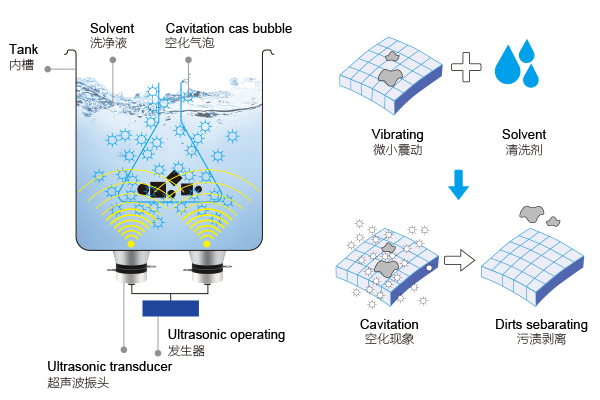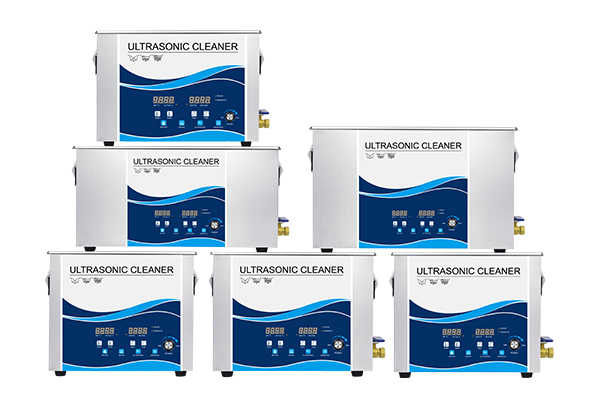Ultrasonic cavitation is the power of ultrasound in the liquid medium caused by a unique physical process, caused by it and a variety of cavitation effects, in the ultrasonic cleaning mechanism plays a decisive role.
The reason for cavitation

Ultrasound is a sparse alternating longitudinal waves, ultrasound propagation in the liquid can make the liquid plasmas appear sparse state and dense state, in the dense-like nimble area, the liquid plasmas under positive pressure, while in the sparse state area is under tension. When the tension exceeds the mutual gravitational force between the liquid plasmas (static pressure), the original dense plasmas will be torn open by the tension of a cavity, forming a vacuum cavity, the gas dissolved in the liquid will instantly enter the cavity to form bubbles. And when the sparse state zone is transformed into a dense state zone, the bubble is again adiabatically compressed and squeezed to collapse. This process is repeated in the ultrasonic field, and the vacuum bubble is continuously generated, grown, collapsed and disappeared, we call this phenomenon cavitation.
Sound intensity and cavitation threshold
Ultrasonic cleaning of cavitation and its sound intensity, if the sound intensity does not reach a certain value, cavitation can not occur. The minimum sound pressure or sound intensity required to make the liquid cavitation, known as the cavitation threshold. In the liquid only when the alternating sound pressure exceeds the static pressure of negative pressure, and negative pressure to exceed the strength of the liquid Hugh to produce cavitation, that is, the sound intensity to be higher than the cavitation threshold to produce cavitation, only ultrasound energy greater than the cavitation threshold to have the cavitation effect. The higher the sound pressure intensity, that is, the higher the power density, the more obvious the cavitation effect. However, the power density is not the greater the better. Power density is too large will produce a large number of useless bubbles, increasing the scattering attenuation, the formation of a sound barrier, weakening the cleaning effect away from the sound source, and may produce cavitation corrosion on the surface of the workpiece.
Types of cavities
Cavities are divided into gas cavities and vapor cavities, gas cavities are dissolved gas in the liquid to form bubbles, bubbles with the ultrasonic shock and growth, the higher the concentration of dissolved gas, the lower the critical value of such cavities occur, it is collapsed when the shock wave pressure is also relatively small.
Vapor cavitation, is a liquid medium with the energy obtained by ultrasound to saturated vapor, and does not depend on the dissolved gas in the liquid, but the formation of additional negative pressure in the ultrasound when the vapor vacuum bubble, the critical value of the acoustic pressure necessary to produce this vacuum bubble than the gas cavitation is more than 10 times larger than the impact pressure is extremely high, so you can produce a good cleaning power.
Cavitation effect and its cleaning effect
In the ultrasonic cavitation of the liquid acoustic field, the rapid collapse of the vacuum bubble around will produce high temperature, high pressure, luminescence, discharge, shock waves and other series of physicochemical effects, collectively known as the cavitation effect.
1、Physical and chemical effects inside the bubble
Vacuum bubble after violent burst collapse, the instantaneous temperature inside the bubble is greater than 5000K, the pressure is greater than 50MPa. high temperature and high pressure generated within the cavitation bubble, the water vapor in the bubble can be decomposed into -H and -OH radicals, as well as the OH combined into H2O2, H2O2 is a strong oxidant, to directly oxidize the water organisms, polymers, conventional conditions difficult to occur in the The chemical reaction is completed.
The high temperature and pressure generated when the cavitation bubble collapses exceeds the critical point of water (Tc=374℃, Pc=22MPa), which also makes the presence of transient supercritical water inside the cavitation bubble and the supercritical water oxidation reaction occurs. Supercritical water is considered to be a good medium for oxidizing organic matter, and can remove the vast majority of organic pollutants in water.
2、Physical and chemical effects outside the bubble
Vacuum bubble after a violent burst collapse, in the moment will also produce a strong outward radiation of the shock wave, the wave speed can be several times the speed of sound. This powerful shock wave will make the structure of the liquid changes, can destroy insoluble pollutants, so that they are quickly crushed and dispersed in the cleaning medium.
In the liquid medium ultrasonic field, the ultrasonic working frequency is how much, accompanied by the same frequency thousands of times per second or more powerful shock wave, which acts on the surface of the workpiece pollutants, on the one hand, destroy the adsorption of dirt and workpiece surface, on the other hand, will also cause fatigue damage to the pollution layer, so that it falls off the surface of the workpiece, if there are tiny cracks in the attached layer exists, cavitation bubbles can also be “drill” into the cracks in the role, so that the attached layer is stripped.
This powerful shock wave on the oil and other pollution layer, due to the emulsification of ultrasonic cavitation, cleaning fluid and oil and dirt two kinds of liquid at the interface of the water-in-oil type emulsion, pollutants will enter the cleaning fluid with the emulsion, it also acts on the shedding of pollutants and cleaning fluid in the microorganisms, bacteria, macromolecular groups, etc., can be crushed, degraded, dispersed.
3、bubbles on the surface of the workpiece scrubbing effect
Air bubbles generated by cavitation, in the vibration of the surface of the workpiece has a scrubbing effect. Once the dirt layer has a gap to drill, the bubble immediately drilled into its vibration, this scrubbing of blind holes, gaps and generally difficult to clean the place can be cleaned very clean.



